Does My Baby Need Teeth to Eat?
- Which finger foods you should wait until your baby has a least one tooth to offer
- Why jaw strength and coordination matters more in chewing than having teeth
- How to modify foods to make them safe for your baby to eat…even before they have teeth
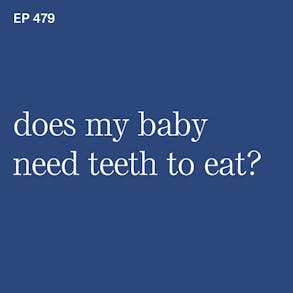
LISTEN TO THIS EPISODE
Episode Description
Does your baby need teeth to eat? Chewing is more about jaw strength and coordination than having teeth…and you would be surprised how many soft foods your baby can eat before they have a tooth or teeth. In this episode we explore how to safely offer finger fods to your baby before they have teeth.

Other Episodes Related to this Topic
- Episode 213 - BLW Teething Tweaks: What Changes Do I Make When My Baby is Teething?
- Episode 254 - How Babies Learn to Chew and Swallow with Dawn Winkelmann, MS, CCC-SLP @msdawnslp
- Episode 469 - Breaking Off a Small Bite: Is This a Choking Risk?
Links from Episode
- Infant Refresher CPR Course - use code KATIE10 for an additional $10 off here
- Baby-Led Weaning with Katie Ferraro program with the 100 First Foods™ Daily Meal Plan, join here: https://babyledweaning.co/program
- Baby-Led Weaning for Beginners free online workshop with 100 First Foods™ list to all attendees, register here: https://babyledweaning.co/baby-led-weaning-for-beginners

Latest Episodes
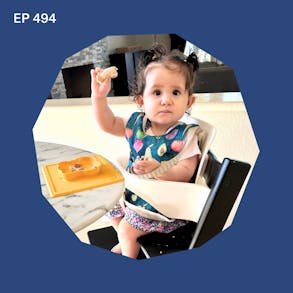

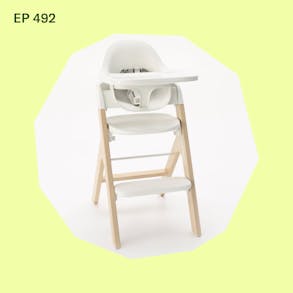
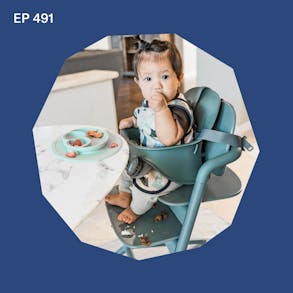
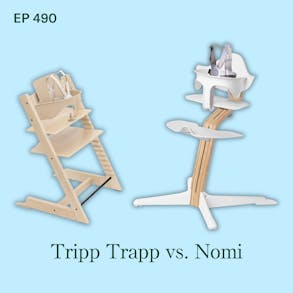
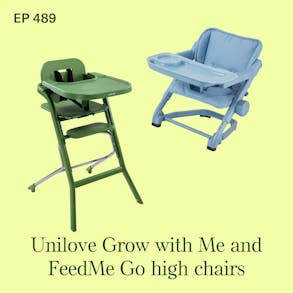
0 (0s):
Are, you about to start Solid Foods, but You don't know where to start. Or. maybe you started with some purees and now you want to make a switch. The best place To get started. learning about starting solid foods safely is my one hour online video workshop called Baby LED WEANING FOR BEGINNERS I just rerecorded this free training and it's packed with videos and visuals on how to safely prep baby led weaning foods, what it looks like for the first few days, how to reduce Choking risk and what to do if your baby has an allergic reaction to food. Everybody on this free training gets a copy of my original 100 First Foods list so you'll never run out of ideas about what to feed your baby. Next, you can get signed up for this video workshop at baby led weaning dot co If.
0 (42s):
you have one hour to dedicate to learning about baby led weaning. Come take this free online video training and grab your copy of that original a hundred FIRST FOODS list. While you're there, again, head to baby led weaning dot co to get signed up and I hope to see you there. I am working with a baby right now whose mom has a really severe peanut allergy. So this family was so scared to introduce their baby to peanut protein, but honestly, the only way to know if your baby is allergic to a food is to actually offer them that food. My preferred way to introduce peanut protein for baby led weaning is with the Puff Works baby peanut puffs. So this particular family, I got them a case of the Puff Works baby peanut puffs. The dad did the introduction since the mom doesn't even like to be like near the peanut, these Puff Works puffs, they have no added sugar and just a smidge of salt for preservative.
0 (1m 30s):
Plus they're the softest nut puffs on the market. So they dissolve really easily in your baby's mouth and you can try these before your baby even has teeth. So you just put a few of the puffs in your baby's suction matter bowl and they pick 'em up and self feed. So this family tried the puff six or seven times over the course of the last weekend. They just sent me the videos. I can hear the mom in the background, the first one she's saying, Katie, I'm so scared. That was at the first try, but their baby did not have a reaction and now they're continuing to reintroduce peanut protein to help further lower their baby's risk of peanut allergy down the road. You can try out the Puff Works baby peanut puffs and get 15% off when you use the affiliate discount code BLW pod@puffworks.com.
0 (2m 11s):
That's B-L-W-P-O d@puffworks.com and get that peanut protein in for your baby early and often too. And I know you might be freaking out like, oh my gosh, my baby just has gums. They don't have any teeth. How are they possibly gonna eat food like chicken or corn? And when it comes to those two particular foods, I don't do any chicken on the bone or meat on the bone for babies before they have teeth. I don't do corn on the cob for babies before they have teeth, but there are certainly different ways that you can modify and make foods like chicken and corn safe for your baby to eat even before they have their first tooth or teeth. Hey there, I'm Katie Ferraro, registered dietician, college nutrition professor and mom of seven specializing in baby led weaning here on the baby led weaning with Katie Ferraro podcast.
0 (2m 59s):
I help you strip out all of the noise and nonsense about feeding, giving you the confidence and knowledge you need to give your baby a safe start to Solid Foods using baby led weaning. Can your baby really go from drinking infant milk directly to eating avocado? I know it sounds like a stretch, but I'll tell you a quick story. There's a family that I'm working with here in San Diego where I live and they have a seven and a half month old baby. His name is Maverick. He's been doing baby led weaning since the baby was six months plus one week old. So that's when we started his first Solid Foods 'cause he was just sitting up on his own then. So they've been at it for about five weeks at this point.
0 (3m 39s):
And Maverick has eaten 25 new foods and they were over the other day. We were doing a baby led weaning coaching session and my friend Paulina, who is also working in the space, she's working on a documentary about starting solid foods. She was there filming the session as well as the baby eating and interviewing the parents and me for her project. So when she was interviewing Maverick's mom and dad, their names are Kelsey and Allen, she was asking them their opinion about, you know, what did you think about starting solid foods? What did you think about baby led weaning before you actually started it with Mav? So Mave is their oldest and their only child. And then kind of comparing and contrasting that to what they think about it now that he's a quarter of the way through his goal of eating a hundred foods before he turns one.
0 (4m 21s):
So I love, I love the mom, Kelsey, she's so real. And Paulina was asking Kelsey and I like, could not keep a straight face 'cause she's like, what did you think about baby led weaning? And Kelsey's like, well at first like I'd seen it on social media and I was like, wait, what? Milk, milk, milk, milk, avocado. Like can my baby really do this? And then we had a whole conversation about, you know, whether or not babies really need teeth and what skillset they need in order to start Solid Foods. And this question of Does My, Baby, Need, Teeth to Eat, it does continually come up from parents who are like, wait a minute, I'm trying to figure out this whole baby led weaning thing, but my baby doesn't have any teeth. So how are they gonna try these? In Mavs case, 25 different foods at this point before he's even cut his first tooth.
0 (5m 4s):
So in today's episode, I wanna go through some of the concerns that parents have about starting solid foods for a baby who does not yet have teeth. And I like to start out each of these mini training episodes with a baby led weaning tip of the day. Today's tip is spoiler alert, I'm gonna give it all away in the first couple minutes here. Your baby does not need teeth to eat. Now there are a certain number of foods and certain types and variations of foods that I do not offer to babies until they do have at least one or more teeth. And hang tight because I will share those with you as well as safer ways to prepare those same foods so that you can offer them to your baby before they get their first tooth or teeth.
0 (5m 43s):
So you're very aware of what's going on inside of your baby's mouth. If you're been putting your finger in there, if you're putting your nipples in there, you know when your baby's gonna be getting a tooth. Their attitude changes. Their demeanor changes. I have a whole podcast episode on teething tweaks that you can make to to the diet when your baby actually does start teething. But you might be surprised to know that some babies are actually born with teeth. So teeth that are present in newborn infants are called natal teeth. Okay? And then the teeth that erupt within the first four weeks after birth, those are called neonatal teeth. Now this is very rare, right? Most babies are gonna be getting teeth somewhere between six and 10 months of age. But just so you know there, it's thought that between one in 1001 in every 6,000 births.
0 (6m 25s):
I know that's a huge range, but the point is like it's super rare for your baby to be born with teeth or to get a tooth within the first month. Now obviously natal teeth may be uncomfortable for a nursing mother. This is not something that happens all the time. But I wanna point out that some babies are born with teeth. And then on the other end of the spectrum, there are some babies who don't even get their first tooth until after they turn one. I have a friend who is a dietician, who has two girls of her own. Both of her girls did not get their first tooth until after they turned one, and yet she successfully did baby led weaning. She did my hundred First Foods approach with those babies. They both ate a hundred different foods with zero teeth before turning one. If you don't yet have a copy of my original a hundred First Foods list and you'd like to grab a copy of that and print it out and put it on your fridge so that your baby can start taking this challenge of trying a hundred foods before they turn one, I give away that a hundred First Foods list to everybody on my free online workshop.
0 (7m 20s):
It's called Baby led weaning FOR BEGINNERS. This is the best place to sit down and in one hour, figure out everything about baby led weaning, look at the research, see the videos of how to make the food, and then everybody on that free workshop gets a copy of that 100 First Foods list. You can sign up for this workshop at baby led weaning dot co slash workshop. You can take the workshop right now, later today, tomorrow when your baby naps. Seriously, whenever it's convenient for you, it's there for you. Again, it's called Baby led weaning FOR BEGINNERS. I teach it. It's online, it's free, and you get the hundred First Foods list at the end. You can register for that workshop at baby led weaning dot co slash workshop. Hey, we're gonna take a quick break, but I'll be right back.
0 (8m 8s):
So let's dive in talking about some of the issues surrounding starting solid foods when your baby does not yet have teeth. Now, what are some common concerns about starting solid foods without teeth? Obviously the fear of choking. So it's important to understand that babies use their gums. Okay, your baby's gums. And you know this, if you're breastfeeding when your baby jumps down on that nipple with those gums, you're like, oh my gosh, that's really strong. your baby will use their gums, which are very strong and very capable of mashing soft foods. Now, sometimes when parents start Solid Foods, they see their baby gagging on food and they think, oh my gosh, they're choking. It is important to understand the difference between gagging and choking. your baby has a natural inborn gag reflex that helps protect their airway.
0 (8m 52s):
And that's going to be activated as they start Solid Foods. And when they get more proficient at actually moving that food around their mouth, more of the food will go to the back of their mouth and that's when the gagging will start. So you're unlikely to see much gagging in the first few days and sometimes even weeks of starting solid foods. And that's 'cause your baby's not actually getting that much food in there, okay? But once they do start getting the food in there and then start moving it around their mouth again without teeth, in most cases, they will activate that gag reflex, push that food forward. That's them protecting their airway so they don't choke on the food that they're not yet ready for. And it's an important part of learning how to eat. Can babies learn how to chew without teeth? Yes, absolutely.
0 (9m 33s):
Chewing is more about jaw strength and coordination than it is about having teeth. Okay? And I mentioned earlier that we're talking about soft foods, okay? There are foods that are better and easier and safer for your baby to mash with their gums. We're talking about apples, for example. Apple is in alphabetical order, the first fruit on the fruit section of my hundred First Foods list. And people say, but Katie, I thought apples were a huge choking hazard. Well, obviously if you offered your baby a hard, crunchy or crispy piece of raw apple, they can't eat that with their gums. But if you peel that same apple and you core it and you slice it and you poach it, which is simmering it in a small amount of water until it is fork tender or just beyond that, we say that it'll pass the squish test.
0 (10m 16s):
And so foods that are soft enough and safe enough for baby lead weenie pass the squish test, meaning that if you were to push that piece of soft cooked apple between your forefinger and your thumb, there would be a little bit of give. So in My program, BABY led weaning with Katie Ferraro, I show you how to make each of the foods on the hundred First Foods list safe for your baby to eat at their particular age and stage, including all hundred of those foods which you can safely do before your baby has even their very first tooth. Now, if you'd like to learn more about how your baby does learn to chew and swallow, I did a fabulous interview with Dawn Winkelman. She's a speech language pathologist and a pediatric swallowing expert. If you go to episode 2 54, it's called How Babies Learn to Chew and Swallow with Dawn Winkelmann.
0 (11m 2s):
And if you'd like to see those videos and get those recipes and all of the instructions on how to make each of the foods on the hundred First Foods list safe, that's all inside of My program. BABY led weaning with Katie Ferraro, and you can sign up for that at baby led weaning dot co slash program. Now, what if your baby swallows large pieces? This is always the fear of parents. Like my baby's actually into this whole eating thing. I figure out how to make the food safe. I've got 'em out there. What if the baby takes a big bite and breaks it off? Well, I recently covered this in an episode dedicated entirely to that topic because it's actually one of the most frequently asked questions. If you go to episode 4 69, it's called Breaking Off, a Small Bite, Is This, a Choking Risk, a small bite or a big bite. 'cause we start with these pinky sized pieces of food in baby led weaning.
0 (11m 45s):
That's the ideal size of a finger food that your baby can pick up with their whole hand or their Palmer grass. But if they break off a piece of that in their mouth, parents are like, like, oh my gosh, I'm freaking out. 'cause a small piece can be a choking hazard. A big piece if the baby can't move around their mouth can also pose a choking hazard. So we give you some strategies in that episode. Again, that's episode 4 69. Breaking Off, a Small Bite Is This a Choking Risk. So let's debunk a couple of myths about why teeth are or are not necessary for starting solid foods. A lot of parents will mistakenly think, oh, my baby's jaw strength is not strong enough. Now, whether you started Solid Foods with breastfeeding or with bottle feeding both of those for six months, right? your baby has been practicing extracting milk either from the breast or from the bottle.
0 (12m 28s):
For our baby who are exclusively breastfeeding, their jaws are working over time to extract that milk from the breast. It's certainly a little bit easier for the babies who are bottle fed, and I'm not calling your baby lazy if they're bottle fed, but they still are exercising those jaws and developing some of that jaw strength in the first half of infancy from zero to six months of age when your baby is sustained entirely by infant milk. Now the act of chewing, which is going to start coming into play in the second half of infancy during the weaning period, after you start Solid Foods at or around or after the six month mark, the act of chewing helps your baby further develop their jaw strength and they also get the coordination part down even before their teeth come in.
0 (13m 11s):
So you'll notice the first few days of starting solid foods, your baby really has no clue what to do with that food in their mouth, and that's perfectly fine because they have their own built-in protective mechanism for pushing the food forward if it gets too far back and they're not yet ready for it. But even a few days into starting solid foods, we start to see babies exhibiting signs of what initially looks like a munch chew, and that will eventually turn into a rotary chew. And dawn, the speech language pathologist goes through the difference between that back in episode 2 54, how babies learn to chew and swallow. So don't stress that your baby doesn't quote unquote have the jaw strength yet they will get the jaw strength as part of the weaning process if you are offering them a variety of different foods and flavors and tastes and textures.
0 (13m 55s):
So that's one of the beauties of this a hundred First Foods approach to starting solid foods is that you're not just sticking to purees. We know from our colleagues in feeding therapy that many of the children that they see in the toddler years, they say, oh my gosh, this entire feeding therapy journey could have been prevented had that baby been allowed to explore with other textures besides purees from the six month mark on, okay, your baby doesn't wake up on their first birthday and magically know how to eat a hundred different foods with lots of different textures. That's what we use the weaning period for. So it's developmentally appropriate for your six month old baby to start practicing with finger foods. And inside of my program, I help you through a texture progression where quite quickly your baby is moving through a variety of different textures so that by the time those teeth do come in, they know how to use them effectively and efficiently to help extract the food from the different modalities that we're offering it and to safely chew and swallow it.
0 (14m 45s):
But it comes with practice. And as we say, practice makes progress. Don't forget that your baby's teeth will typically come in later, okay? Most babies will not get their teeth until somewhere between six and 10 months of age. Yet we want, and we need your baby to start some of those complimentary foods around the six month mark. Remember that breast milk or formula will continue to be an important part of nutrition even after you start Solid Foods. But breast milk or formula is not sufficient to meet the entirety of your baby's needs after the six month mark. That's why we start introducing the complimentary foods to fill some nutrient gaps, but also to help them get the skillset that they need to safely chew and swallow foods so that by the time your baby turns one year of age, most of their nutrition can be coming from food.
0 (15m 29s):
Now, what sorts of foods are safe for toothless babies? Well, we stick to softer textures. I didn't say mainly purees, right? Purees are an important texture for your baby to master. It's just not the only texture your baby can eat. And so we start with soft Mashable foods, okay? Some of the ideal first finger foods for baby led weaning or avocado, banana sweet potato. But I also do chicken and lamb and beef in the first few weeks of starting solid foods, and I can show you how to make those foods safe for your baby. That's again, all inside of My program. BABY led weaning with Katie Ferraro. But the basic gist is if you can shred the meat between your fingers and your thumb, then it's safe for your baby to eat with their gums. So we show you how to take certain cuts of meat like let's take beef for example.
0 (16m 11s):
We don't offer baby steak, right? You can't shred steak with your fingers in your thumb, and a baby can't safely eat it with their gums. But there are other cuts of beef like a beef brisket or a beef chuck roast. You can do country style beef ribs that make nice soft shreddable strips of meat that your baby is safe to eat even before they have their teeth. We do not cut up foods very small for baby led weaning a, because a baby can't pick it up on their own yet. So we're promoting self-feeding, and we want to make the foods in a form that your baby can pick up. They don't have their pinch or grasp because they can't utilize their forefinger and their thumb to pick up small pieces of food when they're just starting out, okay? your baby won't get their pinch or grasp until a little bit later around nine or 10 months of age. And so once they've been eating foods for at least eight weeks, we say this is phase two of our program.
0 (16m 55s):
When you move to phase two, a baby led weaning, when your baby's been eating foods for at least eight weeks and they have their pinch or grasp, that's when we show you how to move to the smaller pieces of food. But we do those longer soft or shreddable, pinky sized adult pinky sized shapes of food earlier on. Now, which foods do we want to avoid? Okay, any, I mentioned the hard, the crunchy, the crispy foods like hard or raw apples or carrots, red bell peppers, or any color bell peppers for that matter. Nuts. I mean, there's lots of different foods that are unsafe for babies because they pose a choking hazard. I personally don't do foods like chicken or meat on the bone or corn on the cob until your baby has at least one or more teeth in order to extract that food from the cob or from the bone.
0 (17m 35s):
But there's lots of ways that you can make foods like chicken safe off of the bone for earlier eaters and foods like corn, there's lots of safe ways to prepare them without offering your baby corn on the cob. As far as parents developing a sense of confidence in their baby's ability to start Solid Foods even before they have teeth, I always remind parents that it's important to take an Infant Refresher CPR Course before you start Solid Foods. Okay? I know you took a CPR course back when your baby was born, before you went to the hospital, but that was six months ago. And I don't know about you, but I can't remember like literally what I had for breakfast this morning, let alone the particulars of a course that I took six months ago. So be sure to get your Infant Refresher CPR Course. Choking on food is a very rare but real risk and CPR can save your baby's life.
0 (18m 15s):
So I take an online CPR course myself every quarter. I linked it up in the description of this episode. You can take that course, it's already very affordable, but if you use the code Katie 10, it will give you another $10 off your Infant Refresher CPR Course. My suggestion is that anybody who helps you feed your baby should also know CPR. So you can do that online course with yourself, your partner, the other people in your house that might help you feed the baby. But everyone should know CPR, and you can get it done efficiently, effectively, and affordably. And there's a link and a code for you there if you wanna check that out. Hey, we're gonna take a quick break, but I'll be right back.
0 (18m 57s):
I also like to remind parents that self-feeding is one way in which we can reduce the risk of choking. There's three primary things that you can do to lower your baby's risk of choking. And I say this with the caveat that putting anything in a baby's mouth, including a spoon or any food, can be a choking hazard. So we let the baby feed themselves. If the baby is the one pacing the eating experience, the risk of choking is reduced. However, as parents, you're responsible for three things and you can reduce the risk of choking by number one, waiting until your baby is really ready to start Solid Foods. If you're not sure what that looks like, it means that your baby is sitting relatively unassisted and they've passed the six month mark or the six month adjusted age if they were born prematurely. I have a bunch of videos on my YouTube channel.
0 (19m 38s):
It's just youtube.com/baby led weaning that show you what babies who are ready to start Solid Foods look like compared to babies who are not. So waiting until your baby is truly ready is the first way that you can reduce choking risk. The second way that you can reduce choking risk is by ensuring that your baby is properly positioned in their high chair. Proper high chair positioning entails your baby's back being flat with their feet resting flat on a solid foot plate. Lots of recommendations on my Instagram page as well as YouTube and here on the podcast about different high chairs that have adjustable footrests or ways that you can adjust the footrest on your own chair if it might not be adjustable, so that your baby's feet can be resting flat. But the third, and I would say the most important thing that you can do to lower the risk of choking is to ensure that you are preparing your baby's foods safely.
0 (20m 22s):
And that's where most of my work comes in, is showing parents how to make those a hundred foods safe for their baby, that they can safely learn to eat them even before they have teeth, because you can't wait until your baby has teeth to start Solid Foods, okay? That could be 11 or 12 months of age, and that's when most of their nutrition can be coming from Solid Foods by that point. Okay? So having or not having teeth has absolutely no bearing on your child's ability to start Solid Foods and their readiness to eat. So if you're stressing out like, oh my gosh, my baby can't eat without teeth, please be reassured that your baby's gums are highly effective, okay? Your babies do not need molar, so those are gonna come much later, okay? But they don't need those big teeth in order to handle Solid Foods, okay? They will use their gums at first, and then as they get teeth, they will learn to adjust so that they can utilize those teeth.
0 (21m 7s):
And then it becomes really fun because then you're like, oh my gosh, this baby can eat pretty much anything if you're not sure if your baby is ready. Remember those signs of readiness to eat, being able to sit relatively on their own being at least six months of age. If you'd like videos of what sitting and readiness looks like, or if you also wanna see videos of babies gagging on food so that you understand why that is different than choking, and you can watch the baby's gag and then go right back to eating food. I encourage parents to watch those videos because it helps them build confidence in their baby's ability to do the same. So I know we're on a podcast where you're learning through your ears, but I have lots of great videos for you on YouTube. That's youtube.com/baby led weaning, or my Instagram channel, which is baby led wean team. So a quick win for you today is that if you have been sticking to purees because you are scared of starting solid foods, please pick out five finger foods that your baby will be eating this week.
0 (21m 57s):
Put a pause on purees. I know your baby knows how to eat purees. You can do that with baby led weaning using what we call the preloaded spoon approach. Okay? Purees are an important texture for your baby to master, but as I mentioned, they're not the only texture that your baby can eat. I want you to pick five finger foods that your baby is going to do next week. If you need to grab that a hundred First Foods list, I give it away to everybody on the free online workshop called Baby led weaning FOR BEGINNERS. You can sign up for that at baby led weaning dot co slash workshop. Or if you wanna check out the full program with my hundred First, Foods, Daily, Meal Plan, all the videos, instructions and recipes that show you how to make those hundred foods safe for your baby to eat at the particular age and stage. That's all inside of the program at baby led weaning dot co slash program.
0 (22m 39s):
So don't be scared about trying new foods, especially finger foods, even if your baby does not have teeth. Thank you so much for listening. I'll link up the resources that I mentioned today, including the CPR course, some of this other episodes, the workshop in the program, on the show notes page for this episode, which you can find@bwpodcast.com slash 4 7 9, and a special thank you to our partners at AirWave Media. If you guys like podcasts that feature food and science and using your brain, check out some of the podcasts from AirWave. We're online@blwpodcast.com. Thanks again for listening, and I'll see you next time.
2 (23m 18s):
From the terrifying power of tornadoes to sizzling summer temperatures, AccuWeather Daily brings you the top trending weather related story of the day, seven days a week. You can learn a lot in just a few minutes with stories about impending hurricanes, winter storms, or even what not to miss in the night sky. So listen and subscribe to AccuWeather Daily wherever you get your podcasts. That's AccuWeather Daily, wherever you get your podcasts.
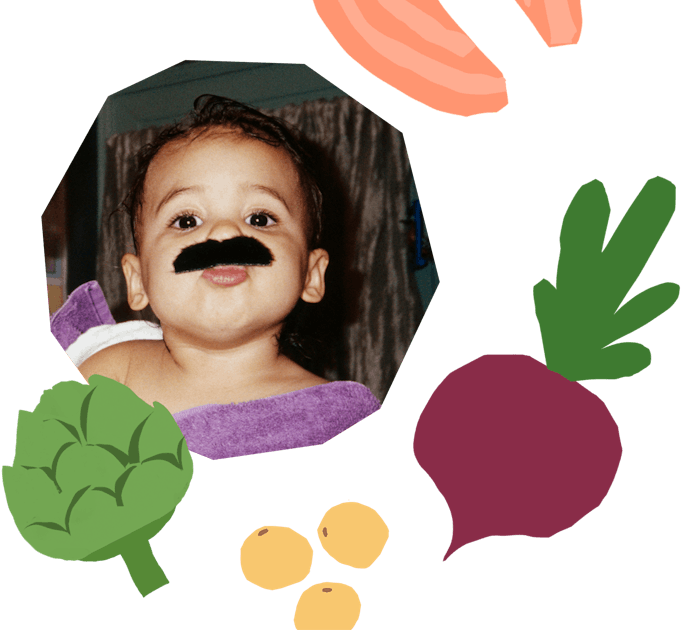
The Program Baby-Led Weaning with Katie Ferraro
A digital course & step-by-step guide for starting solid foods safely with baby-led weaning
 EXPERT-LED, PROVEN APPROACH TO EATING REAL FOOD
EXPERT-LED, PROVEN APPROACH TO EATING REAL FOOD CONCISE VIDEO TRAININGS TO MASTER BABY-LED WEANING
CONCISE VIDEO TRAININGS TO MASTER BABY-LED WEANING 100 FIRST FOODS DAILY MEAL PLAN WITH FOOD PREP VIDEOS
100 FIRST FOODS DAILY MEAL PLAN WITH FOOD PREP VIDEOS
Baby-Led Weaning for Beginners Free Workshop
Is your baby ready to start solid foods, but you’re not sure what to do? Register for this free online video workshop and learn how to give your baby a safe start to solid foods using baby-led weaning. Everyone on this free training receives a copy of Katie’s original 100 FIRST FOODS™ list. You can take this workshop right now, later today when your baby naps, or tomorrow…whatever works for you!
Get baby-led weaning recipes and tips delivered right to your email inbox.